Wondering if your children can join you on the legendary Everest Base Camp trek? For adventure-seeking families who love hiking, this question deserves careful consideration. While the Everest region offers incredible memories and growth opportunities for young trekkers, it also presents unique challenges that require proper planning. In this guide, we'll explore the age-appropriate guidelines for children attempting this iconic journey, outline essential preparation steps to ensure your kids are ready for high-altitude hiking, and discuss the surprising developmental benefits Himalayan adventures can offer growing minds and bodies.
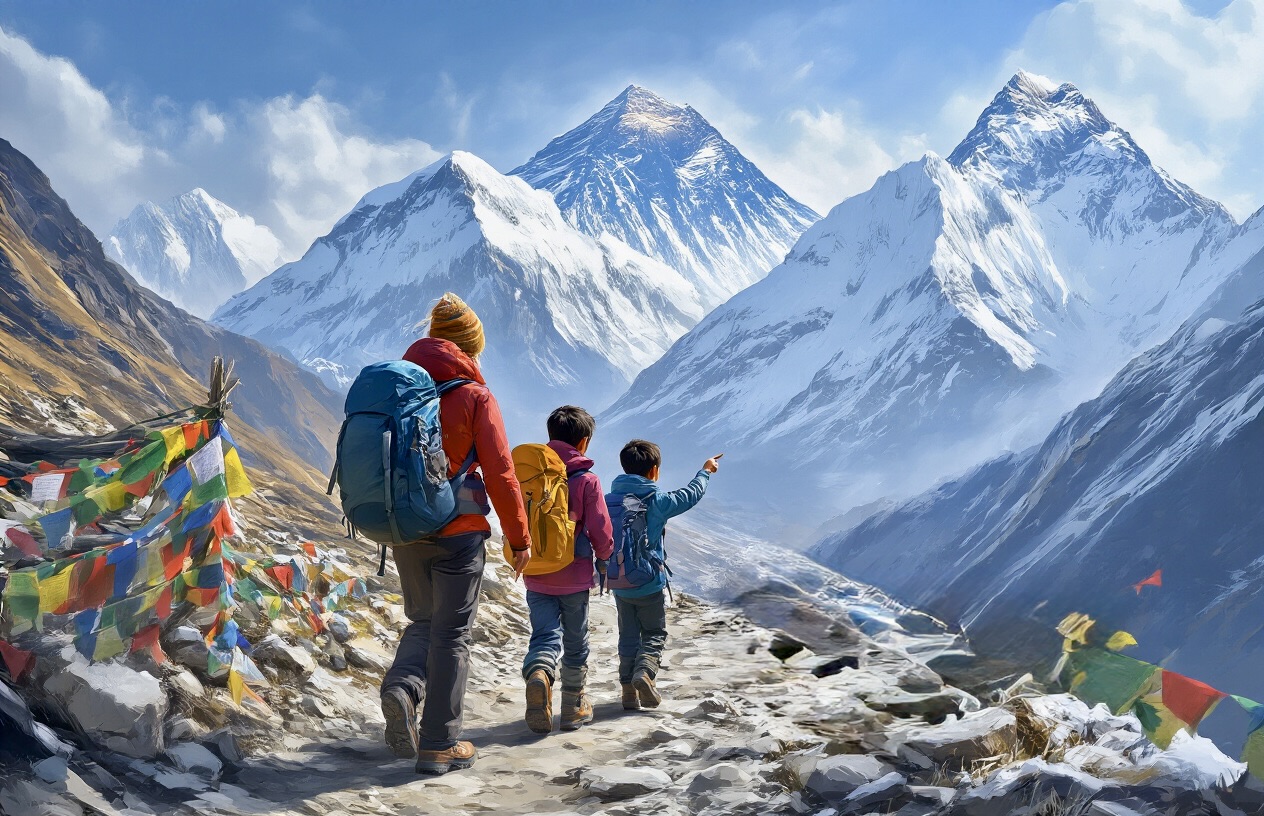
Why Taking Kids on the Everest Base Camp Trek Creates Life-Changing Benefits
Nature Exploration and Environmental Appreciation
The Everest Base Camp trek offers children an unparalleled opportunity to connect with nature at its most magnificent. As we journey through the diverse landscapes of the Himalayas, from lush valleys to dense forests and dramatic high-altitude terrain, children experience the natural world in ways impossible to replicate elsewhere. This deep engagement with nature allows them to witness stunning mountain vistas, glacial rivers, and unique flora and fauna in their natural habitat.
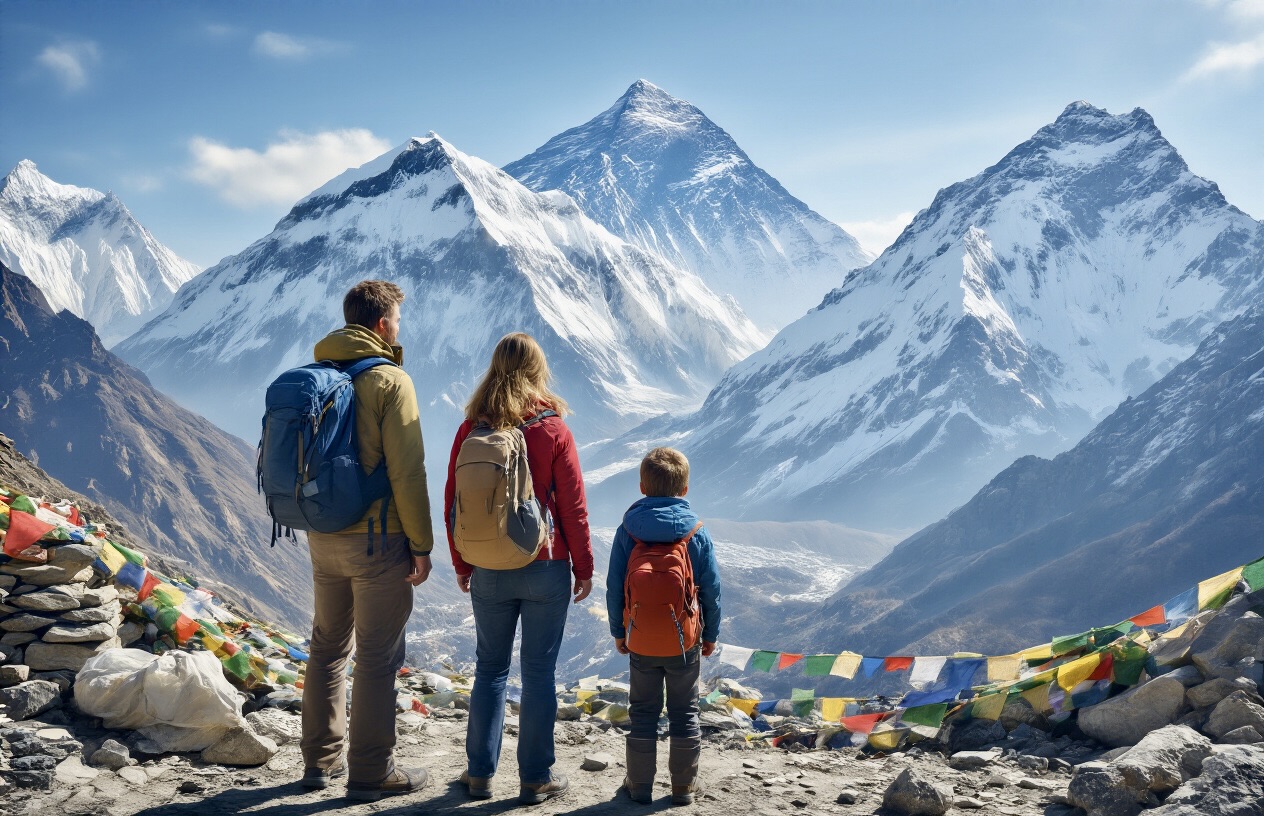
We've found that children who trek through the Everest region develop a profound appreciation for environmental conservation. By observing wildlife such as the Himalayan tahr and pheasants in their natural habitats, kids gain a first-hand understanding of the importance of preserving these pristine ecosystems for future generations.
Physical Fitness and Mental Determination Building
The trek to Everest Base Camp is undeniably a physically demanding adventure that helps children develop outstanding levels of fitness. The varied terrain challenges young trekkers to build cardiovascular endurance, strength, and stamina as they navigate the trails. This physical activity establishes a foundation for a lifelong commitment to fitness and outdoor adventures.
We've witnessed countless children transform during the journey, developing remarkable mental determination as they overcome the challenges of high altitude and demanding trails. Each step toward Base Camp builds resilience and teaches them that perseverance leads to extraordinary achievements.
Educational Value Through Geography and Geology Learning
Trekking to Everest Base Camp serves as an immersive classroom where geography lessons come alive. Children receive practical education about elevation changes, glacial formations, and the impressive geography of the Himalayas. They learn to understand ecosystems, weather patterns, and how altitude affects living conditions—concepts that textbooks alone cannot fully convey.
We ensure kids grasp the environmental challenges facing high-altitude regions, giving them real-world insights that complement and enhance their formal education.
Family Bonding and Teamwork Development
Few experiences strengthen family bonds like trekking together through the Himalayas. The shared adventure of reaching Everest Base Camp creates unbreakable connections as family members support each other through challenges and celebrate achievements together. The trek provides precious uninterrupted time away from digital distractions, allowing families to connect more deeply.
We've seen how working together to overcome obstacles on the trail develops teamwork skills that transfer to everyday life. Families return from the trek with a renewed appreciation for each other's strengths and a deeper understanding of supporting one another through difficulties.
Cultural Understanding and Global Perspective
The Everest Base Camp trek introduces children to the rich Sherpa culture and traditions, providing invaluable exposure to ways of life vastly different from their own. By visiting local villages and monasteries and interacting with Sherpa people, children gain profound insights into diverse cultural practices and beliefs.
We've observed how this cultural immersion fosters respect for diversity and develops global awareness in young trekkers. Children return home with expanded worldviews, greater empathy, and appreciation for different lifestyles—qualities essential for future global citizens.
Personal Growth and Confidence Building
Tackling the physical and mental challenges of the Everest Base Camp trek helps children develop remarkable self-confidence and resilience. Successfully completing such a demanding journey instills a profound sense of accomplishment and pride that stays with them throughout their lives.
We've witnessed the transformation as children overcome obstacles on the trail, learning problem-solving skills and adaptability in changing conditions. The experience of reaching Everest Base Camp demonstrates to children that they can achieve ambitious goals through determination and effort, inspiring them to pursue other challenges with confidence.
Understanding the Challenges of the Everest Base Camp Trek with Children
High Altitude and Oxygen Level Concerns
At Luxury Holidays Nepal, we understand that altitude presents the primary challenge when trekking to Everest Base Camp with children. As you ascend beyond 2,700 meters, oxygen levels decrease significantly, making physical activities increasingly difficult. Children, like adults, need proper time to adjust to these changing conditions.
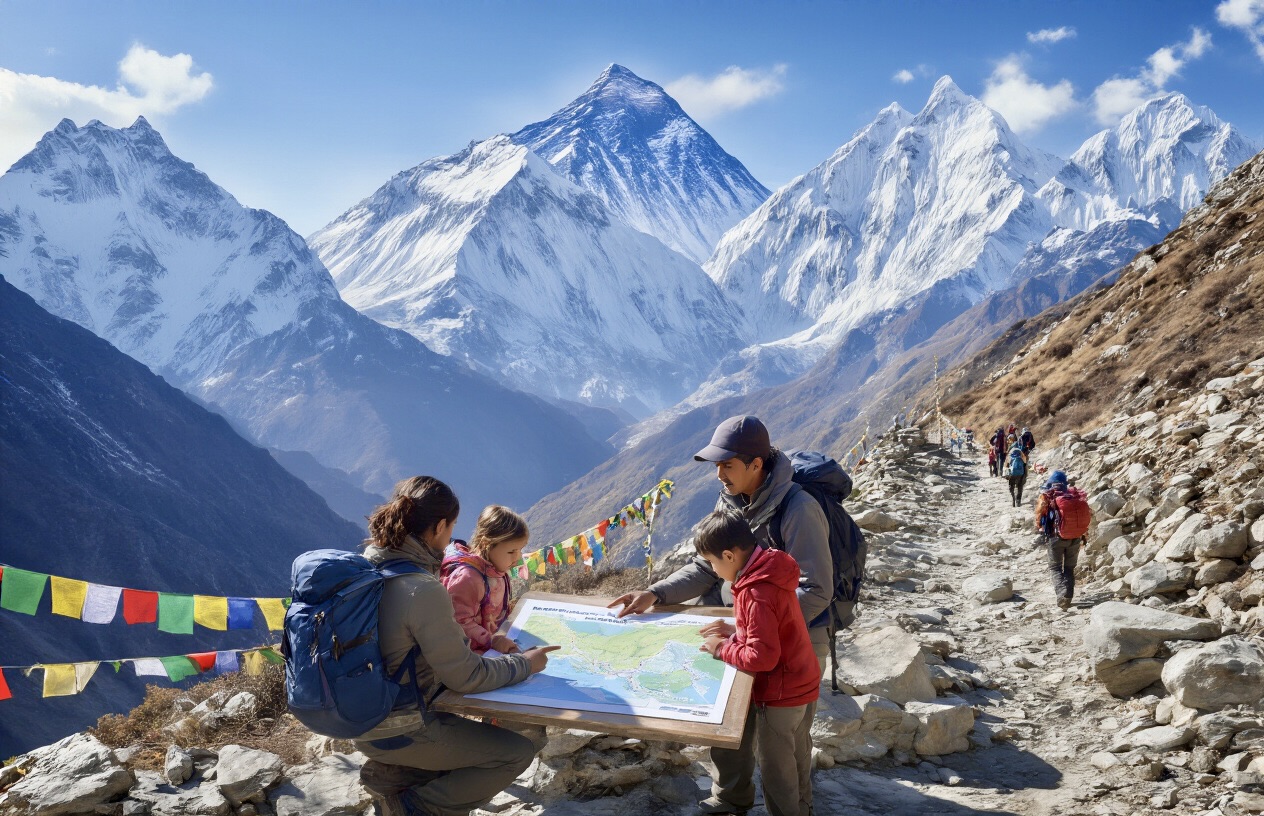
The trek involves gradually climbing to an altitude of 5,364 meters (17,598 feet) at Everest Base Camp, where oxygen levels are approximately 50% of what's available at sea level. We've observed that while children often adapt surprisingly well to altitude changes, their bodies are still developing and require careful monitoring.
Our experience shows that climbing even small hills at high altitudes can leave everyone breathless, with larger ascents causing significant fatigue. This is why we recommend a minimum 8-day ascent from Lukla to Base Camp, allowing ample time for proper acclimatization.
Altitude Sickness Risks and Symptoms Management
While children are not necessarily more susceptible to altitude sickness than adults (especially those ten and older), we take this risk very seriously. The key symptoms to watch for include:
- Headaches
- Nausea or vomiting
- Dizziness
- Fatigue
- Loss of appetite
- Sleep disturbances
We've found that children may not always articulate their discomfort clearly, so we teach parents to observe behavioral changes and regularly check on their children's well-being. Our guides are trained to recognize early warning signs and take immediate action.
The "climb high, sleep low" principle is essential during acclimatization days. We never rush and strictly follow the rule of not ascending more than 500 meters per day once above 2,700 meters. In some cases, even this might be too much for younger trekkers, so we maintain flexibility in our itineraries.
Long Trekking Days and Physical Fatigue
The trek involves walking an average of five to six hours daily, covering approximately 130 kilometers round trip from Lukla. This physical demand can be challenging for children, even those who are active in sports.
Each day involves:
- Morning to afternoon hiking (typically 5-6 hours)
- Regular breaks, including lunch
- Varying terrai,n including steep ascents and descents
We've found that children often handle the fatigue better than adults, but the cumulative effect of multiple days of trekking can take its toll. By day's end, everyone feels significant fatigue, which is amplified by the thin air at higher elevations.
For families with children, we recommend additional rest days and a slower pace than adult-only groups. This approach helps manage energy levels throughout the journey.
Unpredictable Weather and Cold Night Conditions
The Himalayan weather patterns can change rapidly, presenting another significant challenge. During peak trekking seasons (spring and fall), daytime temperatures can be pleasant, but nights get extremely cold, especially at higher elevations.
In our experience, bedroom temperatures in teahouses can drop to near freezing (high 30°F/around 3°C) at locations like Lobuche. This cold is particularly challenging for children who may not be accustomed to such conditions.
We advise parents to:
- Pack quality cold-weather gear including down jackets and warm sleeping bags
- Dress children in layers to adjust to temperature fluctuations
- Be prepared for unexpected weather changes including rain, snow, or high winds
Challenging Terrain and Basic Amenities Limitations
The trek features varied and sometimes difficult terrain that requires good balance and endurance. Rocky paths, steep inclines, and uneven surfaces can be challenging for younger trekkers with shorter legs and developing coordination.
Additionally, the basic living conditions along the route present their own challenges:
- Teahouses provide minimal comfort with platform beds and foam mattresses
- Beyond Tengboche, most accommodations have shared bathrooms with limited sanitation
- Only dining rooms are heated, making evening socialization the warmest part of the day
- Electricity and water are limited luxuries with escalating costs as you ascend
The higher you trek, the more expensive essential items become. At Gorak Shep (the last stop before Base Camp), toilet paper can cost $5 per roll and bottled water $3 per bottle.
Food options also become repetitive and limited. While there's enough variety to maintain nutrition, children accustomed to wider food choices at home might struggle with the menu options available on the trek.
We've learned that for many families, these comfort limitations prove more challenging than the physical aspects of the trek itself, requiring mental preparation and flexibility from all family members.
Age Guidelines and Physical Readiness for Young Trekkers
Recommended Minimum Age of 10 Years
When families ask us about bringing children on the Everest Base Camp trek, we typically recommend a minimum age of 10 years. While there is no official minimum age requirement for the EBC trek, most trekking companies, including our team at Luxury Holidays Nepal, wouldn't allow children younger than 10 years to undertake this challenging adventure. The high altitudes, unpredictable weather conditions, and physical demands of the trek make it unsuitable for very young children.
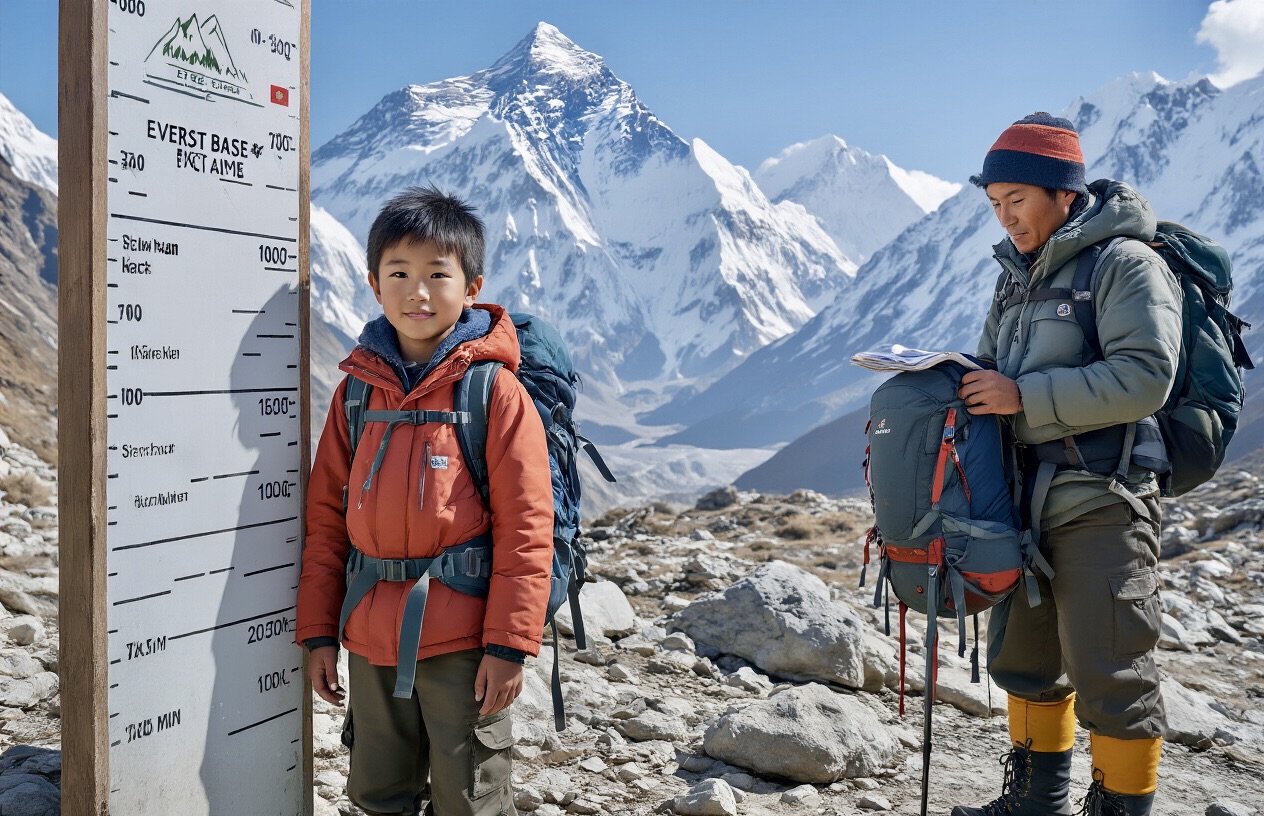
For teenagers between 16-18 years old, we can make exceptions provided they are accompanied by a parent or guardian. Young adults 18 and older are generally considered appropriate for the standard EBC trek itinerary.
Assessing a Child's Fitness Level and Hiking Experience
We believe that physical fitness often trumps age when it comes to successfully completing the Everest Base Camp trek. Before bringing your child on this adventure, it's essential to honestly assess their:
- Previous hiking or trekking experience
- Overall physical fitness and endurance
- Ability to walk for 5-6 hours daily over multiple consecutive days
- Mental resilience and adaptability to new environments
- Experience with altitude (if any)
For children planning to join the trek, we recommend a thorough preparation program including cardio, strength training, and flexibility exercises. Taking your child on progressively challenging day hikes and overnight treks before attempting EBC will help build their stamina and give you a realistic assessment of their capabilities.
Record Achievement by 3-Year-Old Montannah Kenney
While we recommend age 10 as a minimum, there have been exceptional cases of much younger children successfully undertaking parts of the Everest trek. Perhaps the most notable is Montannah Kenney, who at just 3 years old, achieved remarkable progress on the Everest trek route. Her achievement stands as a testament to the fact that individual capabilities can sometimes defy general age guidelines.
However, we must emphasize that such exceptions are extremely rare and should not be used as benchmarks for the average child. Montannah's accomplishment, while impressive, came with careful planning and consideration of her unique abilities.
Individual Assessment Over Strict Age Limits
At Luxury Holidays Nepal, we prefer a personalized approach over rigid age restrictions. We believe in evaluating each child's readiness on an individual basis rather than imposing strict age limits. This assessment should consider:
- The child's physical condition and hiking experience
- Their adaptability to high altitudes
- Mental preparedness for challenging conditions
- The family's trekking experience and ability to support the child
For families with children under 10 or older adults over 60, we can customize child-friendly itineraries with:
- Shorter daily trekking distances
- More acclimatization days
- A slower, more comfortable pace
- Additional rest stops along the trail
- Flexible scheduling to accommodate unexpected needs
We strongly recommend consulting with healthcare professionals before bringing children on high-altitude treks. A thorough medical check-up can help determine if your child is physically ready for the challenges of EBC.
Essential Preparation Steps for Kids' Everest Base Camp Adventure
Comprehensive Health Check-ups and Medical Clearance
Before embarking on the Everest Base Camp trek with children, we strongly recommend conducting thorough medical check-ups for all family members. This crucial step ensures everyone is physically fit for the challenges ahead. Since altitude sickness affects children more severely than adults, getting proper medical clearance is essential. We advise against taking children below ten years of age to Everest Base Camp due to the physical demands and altitude risks.
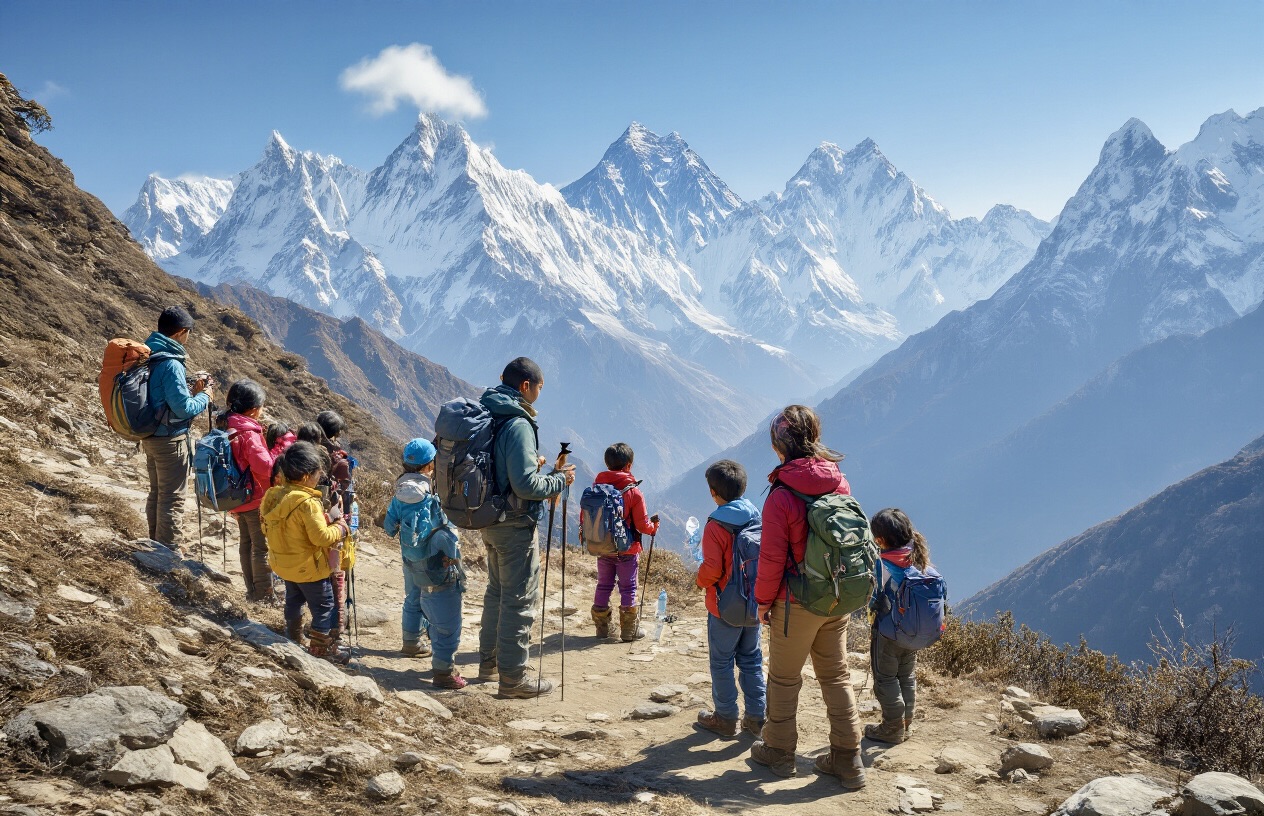
Educational Preparation About Trek Environment and Culture
We believe preparing children mentally is just as important as physical preparation. Before the journey, we take time to educate our young trekkers about the Himalayan environment, cultural aspects, and the importance of following safety guidelines. This enhances their understanding and enjoyment of the journey. Teaching them about geography, local ecosystems, and the significance of Everest helps children appreciate what they'll experience and creates educational opportunities throughout the trek.
Proper Acclimatization Planning and Pacing Strategy
Children are more susceptible to altitude-related issues, so we plan our itinerary with extra acclimatization days. We never rush the ascent and always allow kids to walk at their own pace. For families, we recommend adding more days to the standard itinerary specifically for acclimatization. This measured approach helps minimize the risks of altitude sickness and gives young bodies time to adjust to the decreasing oxygen levels.
Expert Guidance Selection and Experienced Tour Operators
When trekking with children, we choose reputable trekking agencies with extensive experience organizing family treks to Everest Base Camp. Knowledgeable guides can adapt the itinerary and pace to suit the needs of children. At Luxury Holidays Nepal, we've been conducting safe and successful treks for over a decade with guides trained in first aid and emergency response, which is particularly important when trekking with kids.
Appropriate Gear Selection and Equipment Testing
We ensure our kids have appropriate trekking gear, including comfortable and sturdy footwear, warm clothing, and other essentials. Proper equipment significantly enhances their comfort and safety on the trail. We recommend talking with children and examining their clothing and gear to ensure the right fit. Having children try on equipment beforehand is crucial—they may not express discomfort as clearly as adults, so checking fit and comfort before departure saves problems on the trail.
Flexible Itinerary and Weather Timing Considerations
When trekking with children, we always choose a flexible itinerary that allows adjustments based on their needs. This includes modifying trekking distances and adding rest days when necessary. Weather is another critical factor—spring (March, April, and May) and autumn (September, October, November) offer the most stable conditions with clear skies. These seasons make the trails more manageable and enjoyable for young trekkers, with perfect trekking conditions and numerous other trekkers on the way for added safety and socialization.
Critical Safety Measures for Protecting Children on the Trail
Reliable Communication Equipment and Emergency Contacts
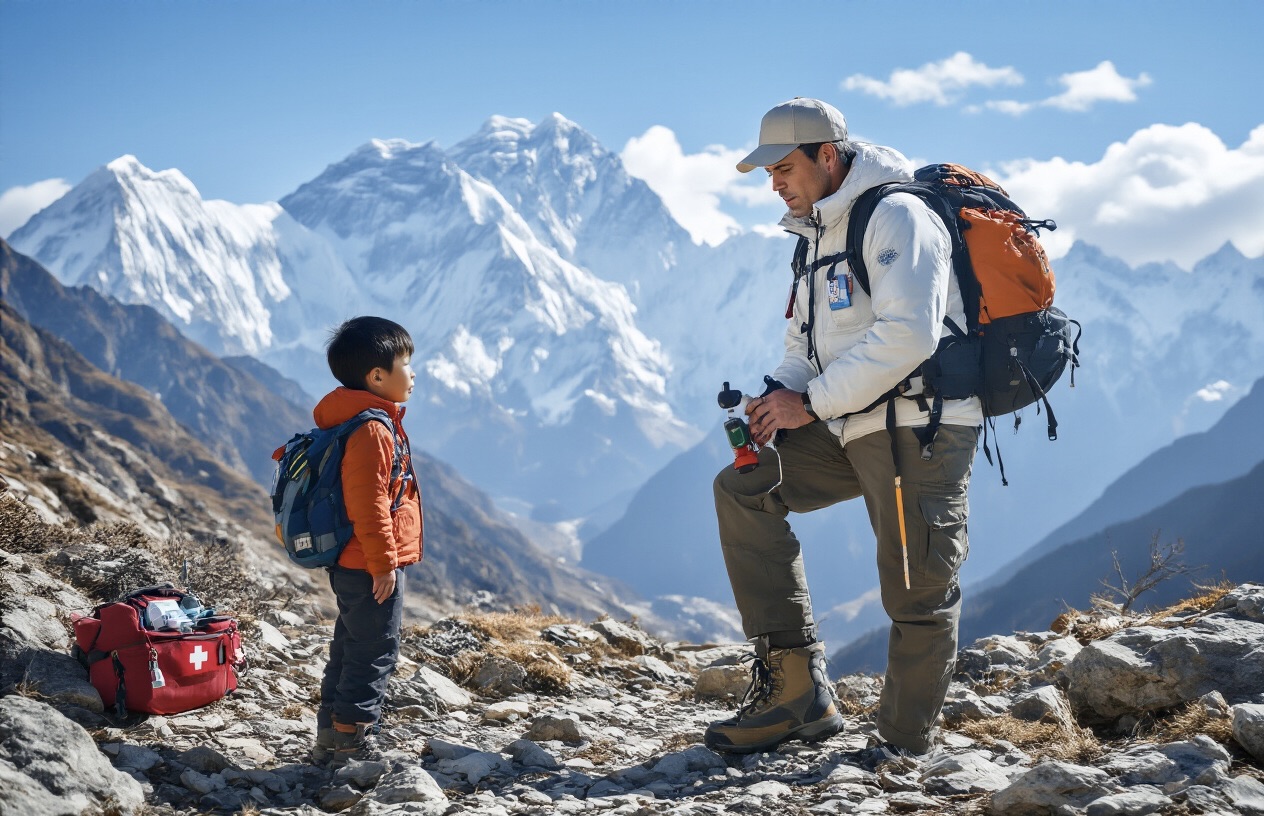
When trekking with children to Everest Base Camp, communication reliability becomes paramount. We recommend carrying multiple communication devices to ensure you're never out of reach:
- Mobile phones: Both Ncell and NTC operators cover most of the trek regions. Purchase prepaid SIM cards before starting your journey.
- Satellite phones: For areas beyond mobile coverage, satellite phones provide crucial backup. Choose models with long battery life and reliability.
- Emergency contact list: We always prepare a comprehensive list including local emergency services, our trekking agency, and insurance providers.
- Communication plan with children: We ensure each child knows how to use communication devices and when to report discomfort or concerns.
Experienced Guides with First Aid Training
At Luxury Holidays Nepal, we never compromise on guide expertise when families are involved:
- Our guides are specially trained in handling family treks and understand children's unique needs.
- All guides have extensive first aid certification and emergency response training.
- Our team members are experienced in recognizing early signs of altitude sickness in children.
- We select guides who demonstrate patience and excellent communication skills with younger trekkers.
Weather Monitoring and Condition Updates
The mountain weather can change rapidly, requiring constant vigilance:
- We check local weather forecasts before and throughout the trek.
- Our team receives regular updates from other guides and stations along the route.
- We make informed decisions about rest days or route adjustments based on incoming weather data.
- Our guides are trained to recognize dangerous weather patterns requiring immediate action.
Proper Trekking Gear and Safety Equipment
Children cannot always express discomfort clearly, making proper gear essential:
- We provide detailed gear lists specifically designed for children at high altitudes.
- All equipment should be tested before departure to ensure proper fit and function.
- Layered clothing is crucial for adapting to temperature fluctuations.
- We recommend quality sleeping bags rated for temperatures lower than expected.
- Sturdy boots with ankle support and proper break-in time are non-negotiable.
Nutritious Food Planning and Safe Water Sources
Proper nutrition becomes even more critical at high altitudes:
- We recommend primarily vegetarian options due to meat hygiene concerns in remote areas.
- Extra dietary supplements such as protein bars should be packed for children.
- Never drink water from local sources including taps, rivers, or wells.
- We always use water bottles filled with treated or boiled water purchased from teahouses.
- Children require more frequent hydration than adults, so we plan accordingly.
Rest Break Scheduling and Fatigue Management
Children have different energy patterns than adults on the trail:
- We schedule frequent, regular rest breaks even when children don't explicitly request them.
- Our guides are trained to recognize signs of fatigue in young trekkers.
- We're always prepared to adjust the trekking pace or add additional rest days as needed.
- We plan shorter daily distances compared to adult-only treks.
- Each day includes a designated quiet time for children to recover properly.
First Aid Kit Preparation and Health Monitoring
Our comprehensive first aid approach includes:
- Specialized children's medications and appropriate dosages.
- Altitude sickness prevention and treatment options suitable for younger trekkers.
- Regular health checks, including pulse and oxygen saturation monitoring.
- Blister treatment supplies and prevention techniques.
- Detailed medical history for each child is accessible to all guides.
Child Education on Risk Recognition and Communication
Before departing, we ensure children understand key safety concepts:
- Age-appropriate education about altitude sickness symptoms.
- Clear instructions on when and how to communicate discomfort.
- Buddy system implementation for added safety.
- Practice sessions using communication devices.
- Reinforcement of the importance of staying hydrated and properly nourished.
- Teaching children to recognize personal limits and speak up without hesitation.
By implementing these critical safety measures, we create an environment where children can safely experience the transformative journey to Everest Base Camp while minimizing risks.
Long-Term Benefits of Himalayan Trekking for Child Development
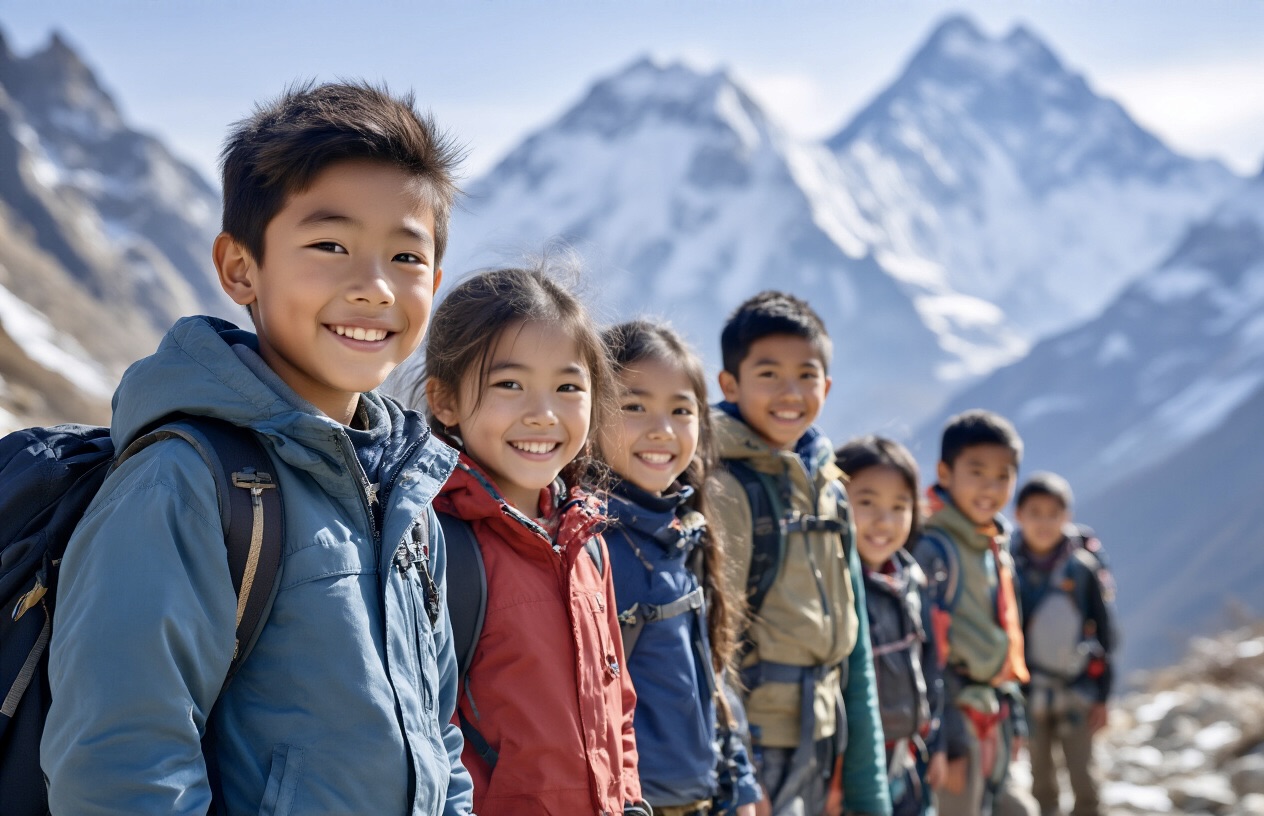
Physical Fitness and Stamina Building
In an era where children are approximately 15% less fit than their parents were at the same age, trekking offers a perfect solution. Rather than being glued to gaming consoles and mobile phones, trekking helps children channel their excess energy constructively. The physical demands of Himalayan trails naturally build endurance and strength as children navigate varied terrain, developing their cardiovascular health and overall fitness in the process.
Resilience and Mental Toughness Development
We've observed remarkable resilience in children who trek in the Himalayas. Take the example of a girls' school trek where students were caught in fierce rain that felt like pellets. Despite being soaked, cold, and shivering, not a single child wanted to quit. They had made an agreement to complete the trek regardless of challenges and stuck with it despite forecasts of more bad weather. Over three days, they braved rain, hailstones, and increasingly colder temperatures, successfully completing their journey and breaking stereotypes about gender, fitness, and privilege.
Environmental Appreciation and Nature Connection
Trekking creates a profound connection between children and nature. As one father observed about his 9-year-old son Amal, "Trekking has brought him closer to nature." On treks, children experience that they are not above or below nature—they are part of it. This realization makes them want to care for their environment.
A perfect example is Shazid, a second-grade student known for his aggressive behavior, who transformed after a trek near Ramnagaram. During the hike, he realized how humans pollute the environment and took it upon himself to clean the trail. After returning, he led his friends to clean their school premises and surrounding areas, impressing his teachers with this constructive channeling of his energy.
Cultural Exposure and Community Understanding
We've noticed that trekking experiences expose children to different cultures and communities, broadening their worldview. In the Himalayan region, children interact with local people, observe different lifestyles, and gain appreciation for diverse traditions. This exposure helps them develop respect for different ways of life and fosters a sense of global citizenship from an early age.
Problem-Solving Skills and Adaptability Enhancement
On treks, resources are limited, teaching city children who are accustomed to having luxuries within easy reach that they can't take things for granted. These experiences curb wastefulness and develop adaptability. Children learn to manage with little and become comfortable with roughing things out—vital skills for life's unpredictable challenges.
Achievement Sense and Self-Esteem Boosting
Trekking helps children discover their true capabilities. Take Rohan, a known troublemaker in his school. During a day trek near Bangalore, we gave him the responsibility to distribute garbage sacks and ensure everyone collected trail litter. He enthusiastically embraced the challenge, even diving into thorny bushes to retrieve trash. After being acknowledged at a school assembly for his efforts, Rohan's self-perception changed dramatically. He began seeing himself as a leader, which transformed his behavior at school.
Lifelong Memory Creation and Family Bond Strengthening
The shared experiences of overcoming challenges create powerful family bonds. We witnessed this with 11-year-old Dhriti on a family trek near Mumbai. During final reflections, her father expressed both sadness and pride as he realized his daughter had grown up. "For the first time, I realize my child has grown up," he said. "She took on so much responsibility for herself and others. She is a lot more independent than I thought."
When we meet children years after their treks, they consistently mention how these experiences played a significant role in shaping who they've become. They talk about how treks taught them to take the good with the bad and prepared them for life's challenges. As one teenager, Vidhi, expressed through poetry after her Chadar trek, these experiences create memories and perspectives that last a lifetime.
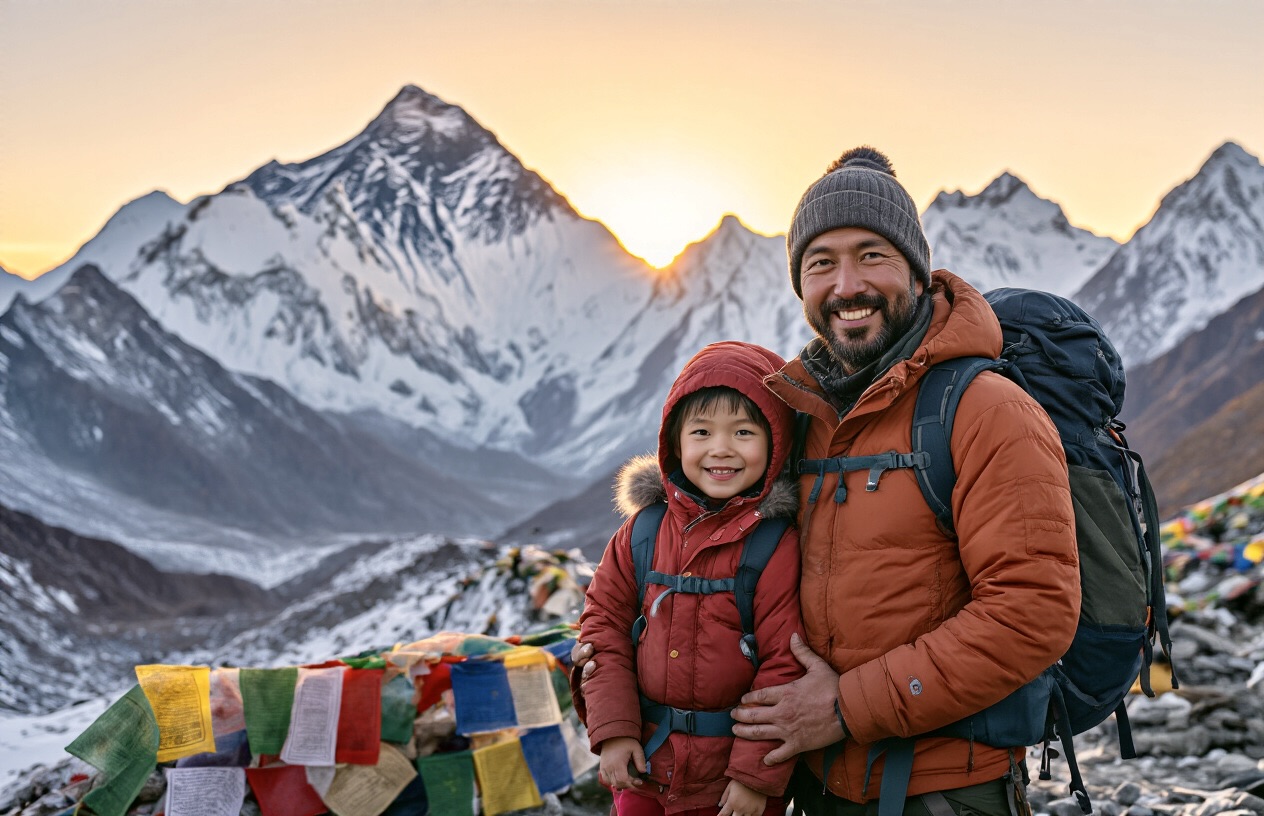
Taking children on an Everest Base Camp trek requires careful consideration, thorough preparation, and realistic expectations. While the journey presents unique challenges like altitude, difficult terrain, and unpredictable weather, the experience can offer unparalleled benefits for young trekkers who are physically prepared and mentally ready for the adventure. With proper age-appropriate planning, safety measures, and gradual acclimatization, children can safely participate in this remarkable journey.
The memories and lessons gained from conquering such a challenge extend far beyond the trek itself. Children develop resilience, environmental awareness, cultural appreciation, and confidence that shape their character for years to come. If you're considering this adventure with your family, take time to assess your child's readiness, prepare adequately, and embrace the journey with patience and flexibility. The Everest region awaits to transform not just your children's perspective of the world, but their understanding of their own potential.
If you need any further information, please contact us by email: [email protected], Phone: +977 985 100 5129 (WhatsApp)




